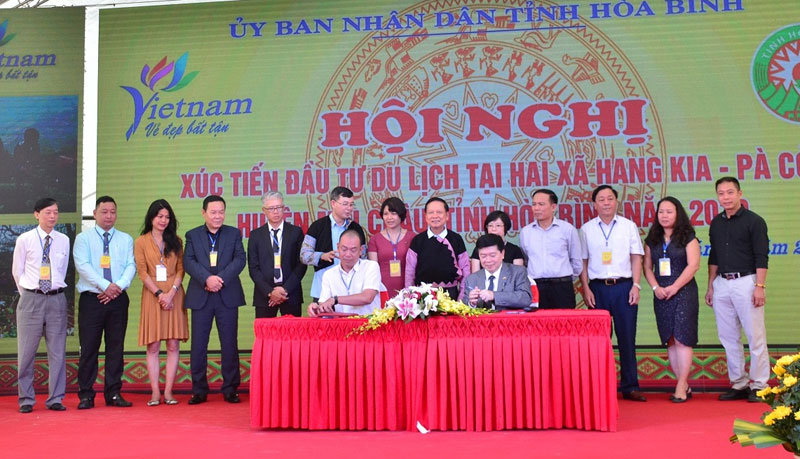
(HBO) – A conference to promote tourism investment in Hang Kia-Pa Co of Mai Chau district was held in Hang Kia commune. The event drew Bui Van Tinh, Secretary of the provincial Party Committee; Ngo Van Tuan, Deputy Secretary of the Party Committee; Nguyen Van Chuong, Vice Chairman of the provincial People’s Committee; and Ngo Hoai Chung, Vice Director of the Vietnam National Administrative of Tourism under the Ministry of Culture, Sports and Tourism, as well as representatives of groups, organisations, businesses and investors, leaders of departments and sectors of Mai Chau, and locals in Hang Kia and Pa Co communes.
Located at about 200km from Hanoi, Hang Kia has abundant
advantages and potential for tourism development.
Hang Kia and Pa Co communes of Mai Chau district is 1,200m above
the sea level with an average temperature of 18.5 Celsius degree. The
localities have maintained the unique cultural values of the Mong ethnic
minority group which accounts for 99 percent of the communes’ population. The
traditional cultural values and craft include weaving, brocade embroidering, fabric
dyeing, and forging.
This is a favourable condition for the province to develop
ecotourism and community-based tourism, inspiring domestic and foreign tourists
to explore and experience.
In Hang Kia and Pa Co, many households have successfully run
homestays. From 2018, the two communes welcomed over 5,000 visitors, 60 percent
of them foreigners.
In order to create favourable conditions for investors to Hang
Kia and Pa Co communes, the provincial People’s Committee has built a list of
potential destinations for designing projects and calling for investment.
 Nguyen Van Chuong,
Vice Chairman of the provincial People’s Committee, signs a memorandum of
understanding on investment cooperation with businesses.
Nguyen Van Chuong,
Vice Chairman of the provincial People’s Committee, signs a memorandum of
understanding on investment cooperation with businesses.
Addressing the conference, Ngo Hoai Chung, Vice Director of
the Vietnam National Administration of Tourism, lauded the great tourism
development potential of Hoa Binh and Hang Kia and Pa Co communes in
particular.
Meanwhile, Bui Van Tinh, Secretary of the provincial Party
Committee, pledged to create optimal environment for investors and businesses
to effectively tap the potential and strengths of the province in tourism.
At the conference, the People’s Committee of Hoa Binh signed
a memorandum of understanding with 8 groups and investors on cooperation in
tourism in Hang Kia and Pa Co.
On the occasion, the Steering Committee on Tourism
Development of Mai Chau offered four sets of equipment worth 100 million VND to
four homestay households in the two communes.
According to data from the Hoa Binh Provincial Party Committee, the industrial production index for the first six months of 2025 is estimated to have increased by 20% compared to the same period last year. This marks the highest year-on-year growth rate for this period since 2020.
In the first six months of 2025, Hoa Binh province’s export turnover was estimated at 1.145 billion USD, marking an 18.11% increase compared to the same period in 2024. Import turnover was estimated at $ 804 million, a 17.15% increase, which helped the province maintain a positive trade balance.
The lives of the ethnic minority farmers in Tan Lac district have gradually improved thanks to the new directions in agricultural production. This is a testament to the collective strength fostered through the professional associations and groups implemented by various levels of the district’s Farmers’ Union.
With the motto the "product quality comes first,” after nearly one year of establishment and operation, Muong village’s Clean Food Agricultural and Commercial Cooperative, located in Cau Hamlet, Hung Son Commune (Kim Boi district), has launched reputable, high-quality agricultural products to the market that are well-received by consumers. The products such as Muong village’s pork sausage, salt-cured chicken, and salt-cured pork hocks have gradually carved out a place in the market and they are on the path to obtaining the OCOP certification.
In the past, the phrase "bumper harvest, rock-bottom prices" was a familiar refrain for Vietnamese farmers engaged in fragmented, small-scale agriculture. But today, a new spirit is emerging across rural areas of Hoa Binh province - one of collaboration, organisation, and collective economic models that provide a stable foundation for production.
Maintaining growing area codes and packing facility codes in accordance with regulations is a mandatory requirement for agricultural products to be eligible for export. Recently, the Department of Agriculture and Environment of Hoa Binh province has intensified technical supervision of designated farming areas and packing facilities to safeguard the "green passport" that enables its products to access international markets.



 Nguyen Van Chuong,
Vice Chairman of the provincial People’s Committee, signs a memorandum of
understanding on investment cooperation with businesses.
Nguyen Van Chuong,
Vice Chairman of the provincial People’s Committee, signs a memorandum of
understanding on investment cooperation with businesses.